Kutna Hora
Travel Stories - Czech Republic
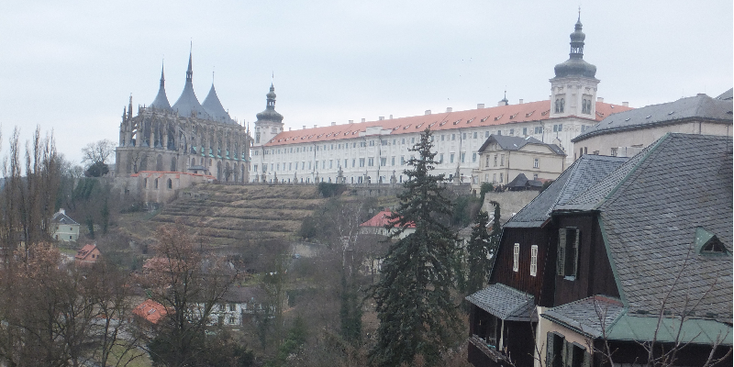
introduction
Kutná Hora was founded in the 12th century as a mining settlement, because of the rich silver reserves that were available here. The silver found by the monks was hidden under their religious houses (cunts) hence the name Kuttenberg. The city grew rapidly and at the beginning of the Hussite Wars in 1419 Kutná Hora was the most important city in Bohemia after Prague. It even became the most beloved city of several Bohemian Kings.
The city continued to compete for power with the current capital in economic, cultural and political terms until the end of the 16th century when the mines were exhausted. The Bohemian empire had already been taken over by the Habsburg dynasty at that time. The historic center of the old silver city, with its monuments since 1995 on the World Heritage List of UNESCO and is a much visited tourist destination. Today the city has about 25,000 inhabitants.
The most important sights of Kutna Hora are the ossuary of Sedlec (the bones church), the Italian Court (Vlassk'y dvur), the St. Barbara Cathedral and the St. Jacobs or St. John's Church. This tower is slightly tilted by a collapsed mine beneath it. Further attractions are the Jesuit College, Hrádek, various historic houses (including the stone house) and the stone fountain.
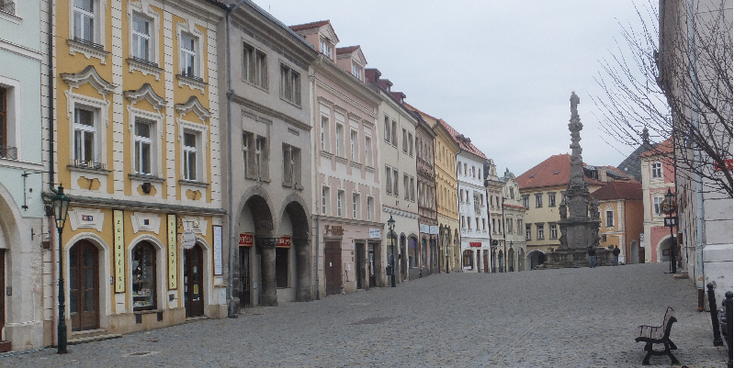
The bones chapel
When I arrive in Kutna I follow the signs to the center, see in the distance the top of our dear lady church and turn right there. Now I walk straight to the one of the largest but also most remarkable sites of the Czech Republic even though you can not see it from the outside.
It is a small church, which is now unfortunately in scaffolding, a low stone wall behind it which encircle a small cemetery. I walk under a stone gate, past some tombs and then enter the bones church or Kostnice Sedlec Ossurary. At a small counter you can buy different tickets - I decide to do this only (I have seen enough churches) and see the first bones already hanging on the sides. In a niche behind me is a large vase made of skulls and bones. It is lugubrious, art and enigmatic and I do not know what to think about it. Surrounding a hedge of human skulls and bones such as the known "pirate" symbols.
Above the stone staircase that leads down into the cellar, you can see the weapon-logo of the family who lived here - naturally with bones of cymbals, arms, legs and heads. I walk down where in the middle of the altar there are four wooden shelves in a triangle shape on which a row of vertically placed skulls stand up as decoration. There must be a total of about 40 to 70 thousand people's bones here, many of which occupy the ornaments of this church.
I read further that history actually started here with a handful of earth from the holy mountain Golgotha where Jesus would be crucified. This was scattered on the cemetery around the church. Then the interest to be buried here increased hand over hand. People came from far and wide to be buried here. Expansion was certainly there when the plague broke out and then the war with the Hussiten. Years later it was decided to build a church on the cemetery and many graves had to be mined. The cemetery was further reduced and the bones were temporarily stored in the basement of the church. When the church became the property of a family in the 19th century, an artist was asked to make something "beautiful" from all those bones with this as a result..
I trudge over the cemetery and take a look in the chapel at the top of the church but I have seen enough and walk back to the road. There is an information center and I decide to ask for a map of the city because my copy of the hostel is not really adequate. After picking up the map, I decide to walk the last 2 km to the center of the city.

Hotel California
I can not miss it when I walk into the center - I take a look at a large information board with the most important sights of the city and decide to walk a little circle and then return to the train station. I walk into the first street and note that all shops are closed. Of course I know it is Sunday but had expected from such a tourist town that something would be open.
Perhaps for that reason, there is hardly anyone on the street that only does the beauty well. Of course, the city is a bit like cities such as Telc and Tabor, but especially the architecture is diverse and beautiful. It reminds me a bit of "Art Nouveau" with different colors and shapes. On this square a whole row of colorfully colored houses has been built, as you often see in the Czech Republic. But no matter how often you see it, it remains a beautiful sight.
The stone house is a mix between the gray hotel building that I have just stood for and the beautiful decorated cream-colored house that could be seen next to it. Here a lot of Christian images because I think it was or still is a church - but it looks like its size and shape as an ordinary house which is very richly decorated. At the end of the street is the "stone fountain" in the middle of a junction. It is a 3 or 4 meter high stone wall built in a circle with a number of water jets.
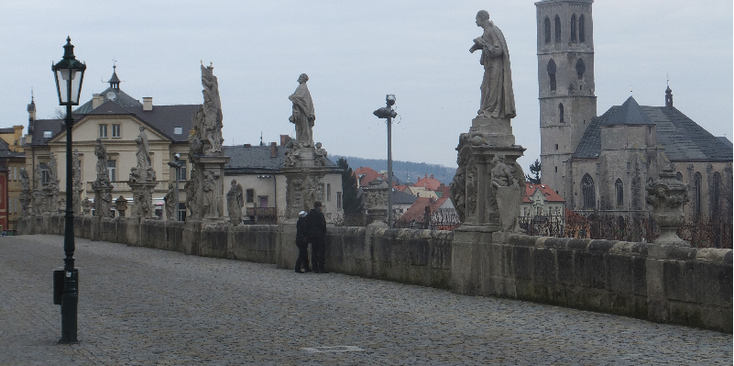
The Jesuit college
I arrive at the Jesuiten college, a large building which could easily stand also in grandeur cities like Vienna or Budapest. There are onion-shaped domes, such as an Eastern European church has and is painted in soft colors. The road there is similar to that of the Charles Bridge in Prague and is blessed with stone statues on the side of where the valley is. It is like a Royal road and I hang over the stone wall for a moment so that I have a view of the valley.
A beautiful panorama of the Czech landscape - here you can see the St.Jacobs church but also the train track with its railway bridge and the cottages in the Kutna Hora valley. Eventually you end up on a small square so that you can see the beautiful "St. Barbara "church can see in full glory. Here it is busy with tourists and tour groups. You can walk all around the church but since I do not have a ticket I can not go inside. I walk back over the pebbles towards the center and here again beautiful old wooden houses painted in different colors in a friendly atmosphere. Old small alleys with cobbled stoned roads and antique lampposts.
A dazzling blue gate and a yellowish castle - real jewels hidden in backstreets. It is now really time to go back and I walk out of the center looking for the train station. Eventually a small train arrives which travels the few kilometers to the main station. I also have to wait more than half an hour for this to take me to Kolin. From there I transfer to the train to Prague.
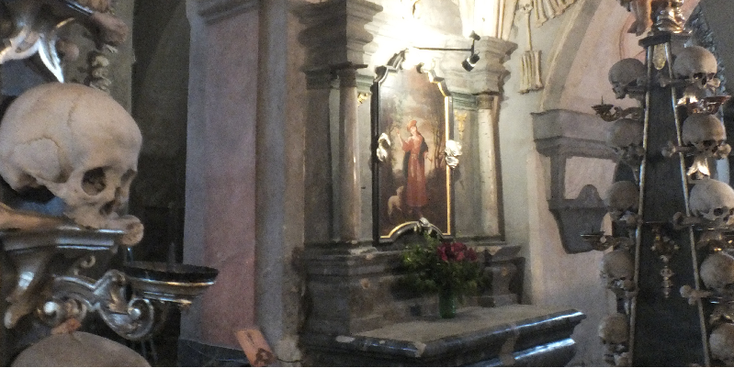
tips & advice (2015)

Prague - Kutna Hora: there are only trains to Kutna Hora, no busses. These go from the central station and go every 2 hours (08:00, 10:00, etc.) also on Sunday. The journey takes a little over an hour. Cost: 210 CZK for a return ticket.
There are two train stations in KH - one is called mesto and is in the city itself - the other is about 3 to 4 km away in the suburb Sedlec. Small trains run between these two stations.
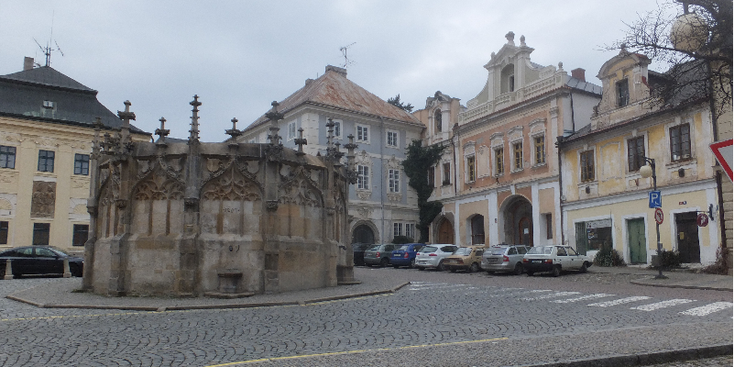
see also:
LANDEN:
EUROPA:
Albanië * België * Bosnië-Herzegovina * Bulgarije * Denemarken * Duitsland * Engeland * Estland * Finland * Frankrijk * Griekenland * Hongarije * (Noord) Ierland * Italië * Kosovo * Kroatië * Letland * Litouwen * Luxemburg * Macedonië * Malta * Montenegro * NEDERLAND * Oekraïne * Oostenrijk * Polen * Portugal * Roemenië * Rusland * Schotland * Servië * Slovenië * Slowakije * Spanje * Tsjechië * Turkije * Zweden
NOORD EN CENTRAAL-AMERIKA:
Chili * Costa Rica * Cuba * Guatemala * Mexico * Nicaragua * Panama * Verenigde Staten
ZUID-AMERIKA:
Argentinië * Bolivia * Brazilië * Colombia * Ecuador * Peru
AFRIKA:
Botswana * Burkina Faso * Egypte * Ethiopië * Ghana * Kenia * Mali * Marokko * Namibië * Oeganda * Senegal * Tanzania * Tunesië * Zuid-Afrika
MIDDEN-OOSTEN:
Iran * Israël * Jordanië * V.A.E.
AZIE:
Armenië * Cambodja * China * Filipijnen * Georgië * India * Indonesië * Japan * Kirgizië * Laos * Maleisië * Mongolië * Myanmar * Nepal * Oezbekistan * Singapore * Sri Lanka * Thailand * Vietnam
OCEANIE:
Voor meer reisfoto's kijk op www.instagram.com/cheapskatetravel.nl:
© Cheapskatetravel.nl; 2018 (all rights reserved)


